|
 Dermocybe castaneodisca Dermocybe castaneodisca
SynonymsCortinarius castaneodiscus
BiostatusPresent in region - Indigenous. Endemic
Images (click to enlarge)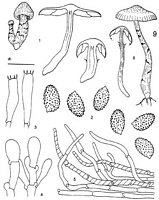
Caption: Dermocybe castaneodisca: 1. carpophores. - 2. spores. - 3. basidia. - 4. cheilocystidia. - 5. pileipellis. - 6. carpophores (ZT 68/338). | 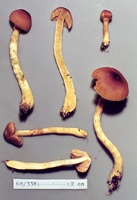
Caption: ZT68-338
Owner: E. Horak: © Creative Commons Attribution-Noncommercial 3.0 New Zealand | 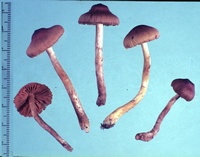
Caption: ZT76-239
Owner: E. Horak: © Creative Commons Attribution-Noncommercial 3.0 New Zealand | 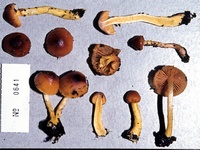
Caption: ZT0641
Owner: E. Horak: © Creative Commons Attribution-Noncommercial 3.0 New Zealand | 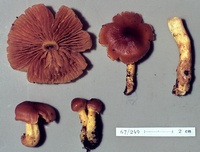
Caption: ZT67-249 , Holotype
Owner: E. Horak: © Creative Commons Attribution-Noncommercial 3.0 New Zealand |
Article: Horak, E. (1988) [1987]. New species of Dermocybe (Agaricales) from New Zealand. Sydowia 40: 81-112.
Description: Pileus -50 mm, hemispherical or conico-convex becoming broadly umbonate or campanulate; red-brown or chestnut brown at centre, yellow or orange towards margin; viscid to subglutinous when moist, innately fibrillose in dry condition, often radially wrinkled, hygrophanous, margin distinctly striate, with fibrillose to agglutinated semipersistent veil remnants along margin. - Lamellae 10-20,5(-7), emarginate and subdecurrent with short tooth, ventricose, -5 mm wide; yellow, ochre or orange at first turning rust orange in mature specimens, edges concolorous or paler, fimbriate or subserrate from cheilocystidia. - Stipe -70 x -7 mm, cylindrical or subclavate, often subfusoid at base, single or cespitose; sulphur yellow to yellow-ochre, below fugaceous cortina with several yellow to yellow-brown viscid zones and belts of veil; dry (except veil remnants when fresh), longitudinally fibrillose, hollow, often with yellow rhizomorphs. - C o n t ex t yellow-orange in pileus and stipe. - Odour and taste raphanoid (or like raw potatoes), often faint. - Chemical reactions on pileus: KOH - red; HCl, NH3-negative.
Spore print rust brown. - Spores (7-) 7.5-9.5 x (4-) 5-6 µm, ovoid, verrucose, rust-brown. Basidia 25-40 x 7-10 µm,4-spored. - Cheilocystidia conspicuous, composed of articulated cellchains, terminal cells (10-30 x 12 µm) ovoid or clavate, membranes thin-walled, hyaline. - Pileipellis a cutis or trichoderm composed of cylindrical hyphae (4-8 µm diam.), terminal cells cylindrical or fusoid-conical, membranes gelatinized, with red-brown to purple-grey plasmatic pigment dissolving in KOH, subcuticular layers cellular. - Clamp connections present.
Habitat: On soil in Nothofagus-forest (N. solandri var. cliffortioides-fusca-menziesii), sometimes in mixed stands with Leptospermum spp. - New Zealand.
Notes: In New Zealand D. castaneodisca is found to be a common species in mixed Nothofagus-Leptospermum forests. There is ecological evidence, however, that this agaric can enter ectomycorrhiza only with Nothofagus spp. (HORAK, unpubl.).
Macroscopically D. castaneodisca is recognized by the yellow-orange pileus with maroon red disk. In moist conditions both the pileal surface and the yellow-orange veil remnants scattered over the stipe are viscid or glutinous. Based upon these characters D. castaneodisca must be considered a typical representative of Dermocybe subgen. Icterinula (MOSER & HORAK, 1975). Seven different pigments have been extracted from carpophores of D. castaneodisca. Apart from endocrocin, however, the molecular properties of the remaining six components are not yet elucidated (KELLER & al., 1988).
|